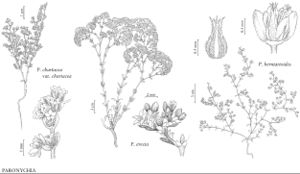Paronychia erecta
Sida 1: 102. 1962.
Plants perennial (occasionally biennial), often matted; taproot stout. Stems prostrate to ascending, branched especially distally, retrorsely to spreading-pubescent throughout (when pubescent); flowering stems 8–48 cm; sterile stems 2–10 cm. Leaves: stipules ovate-lanceolate, 2–12 mm, apex acuminate, entire; blade linear to spatulate-oblanceolate, 4–40 × 1–4 mm, leathery, apex obtuse to acute, moderately antrorsely pubescent. Cymes terminal, 15–200+-flowered, branched, densely to loosely grouped to form subcorymbose clusters 5–50 mm wide. Flowers 5-merous, narrowly ellipsoid, with slightly enlarged hypanthium and calyx tapering distally, 2.3–3.5 mm, glabrous to slightly puberulent proximally with straight to hooked hairs; sepals red-brown, white or whitish distally, veins absent, narrowly oblong to lanceolate-oblong, 1.4–2 mm, papery, margins white, ca. 0.1 mm wide, papery, apex rounded, hood formed from slight incurving, awn or mucro absent; staminodes narrowly oblong, 0.4 mm; style 1, cleft in distal 1/10, 1.3–1.7 mm. Utricles ovoid to ellipsoid, 1–1.2 mm, rugulose, glabrous.
Phenology: Flowering spring–fall.
Habitat: Coastal dunes, sandflats, pine/oak woodlands
Elevation: 0-100 m
Distribution

Ala., Fla., La., Miss.
Discussion
Plants with pubescent stems, strigose leaves, and pubescent receptacles have been recognized as var. corymbosa.
Selected References
None.
